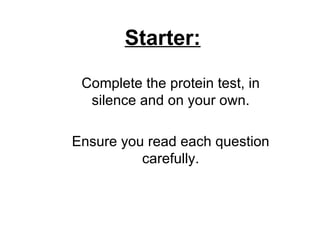Protein; meat
•Als PPT, PDF herunterladen•
5 gefällt mir•3,663 views
Protein Meat structure, nutrition, cooking methods, religion, health scares
Melden
Teilen
Melden
Teilen

Empfohlen
Quality control of meat and chicken

Quality control of meat and chickenPVNRTVU, College of Veterinary Science,Rajendranagar, Telangana, India
food and water, Food Chemistry, Constituent of foods i.e water carbohyfrate l...

food and water, Food Chemistry, Constituent of foods i.e water carbohyfrate l...Muhammad Naveed Laskani
Weitere ähnliche Inhalte
Was ist angesagt?
Quality control of meat and chicken

Quality control of meat and chickenPVNRTVU, College of Veterinary Science,Rajendranagar, Telangana, India
food and water, Food Chemistry, Constituent of foods i.e water carbohyfrate l...

food and water, Food Chemistry, Constituent of foods i.e water carbohyfrate l...Muhammad Naveed Laskani
Was ist angesagt? (20)
NOVEL Food Processing Technologies: Emerging Applications, Research and Regul...

NOVEL Food Processing Technologies: Emerging Applications, Research and Regul...
food and water, Food Chemistry, Constituent of foods i.e water carbohyfrate l...

food and water, Food Chemistry, Constituent of foods i.e water carbohyfrate l...
Andere mochten auch
Andere mochten auch (10)
Ähnlich wie Protein; meat
Ähnlich wie Protein; meat (20)
Introduction-Chemical composition- Quality attributes.pptx

Introduction-Chemical composition- Quality attributes.pptx
Meat skeletal muscles with natturally attached tissues

Meat skeletal muscles with natturally attached tissues
Classification of-commodities2204-120114234912-phpapp02

Classification of-commodities2204-120114234912-phpapp02
Mehr von Northgate High School
Mehr von Northgate High School (20)
Kürzlich hochgeladen
YOUVE_GOT_EMAIL_PRELIMS_EL_DORADO_2024.pptx

YOUVE_GOT_EMAIL_PRELIMS_EL_DORADO_2024.pptxConquiztadors- the Quiz Society of Sri Venkateswara College
FINALS_OF_LEFT_ON_C'N_EL_DORADO_2024.pptx

FINALS_OF_LEFT_ON_C'N_EL_DORADO_2024.pptxConquiztadors- the Quiz Society of Sri Venkateswara College
Kürzlich hochgeladen (20)
Barangay Council for the Protection of Children (BCPC) Orientation.pptx

Barangay Council for the Protection of Children (BCPC) Orientation.pptx
ENGLISH 7_Q4_LESSON 2_ Employing a Variety of Strategies for Effective Interp...

ENGLISH 7_Q4_LESSON 2_ Employing a Variety of Strategies for Effective Interp...
Visit to a blind student's school🧑🦯🧑🦯(community medicine)

Visit to a blind student's school🧑🦯🧑🦯(community medicine)
Global Lehigh Strategic Initiatives (without descriptions)

Global Lehigh Strategic Initiatives (without descriptions)
Incoming and Outgoing Shipments in 3 STEPS Using Odoo 17

Incoming and Outgoing Shipments in 3 STEPS Using Odoo 17
Difference Between Search & Browse Methods in Odoo 17

Difference Between Search & Browse Methods in Odoo 17
Influencing policy (training slides from Fast Track Impact)

Influencing policy (training slides from Fast Track Impact)
Protein; meat
- 1. Starter: Complete the protein test, in silence and on your own. Ensure you read each question carefully.
